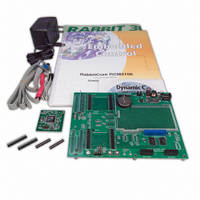101-0533 Rabbit Semiconductor, 101-0533 Datasheet - Page 30

101-0533
Manufacturer Part Number
101-0533
Description
KIT DEV RABBIT3000/RCM3100
Manufacturer
Rabbit Semiconductor
Series
RabbitCore 3000r
Type
MPU Moduler
Datasheet
1.101-0517.pdf
(110 pages)
Specifications of 101-0533
Rohs Status
RoHS non-compliant
Contents
RabbitCore Module, Dev. Board, AC Adapter, Cable and Dynamic C® CD-Rom
Processor To Be Evaluated
RCM3100
Interface Type
RS-232, Ethernet
Maximum Operating Temperature
+ 85 C
Minimum Operating Temperature
- 40 C
Operating Supply Voltage
3.15 V to 3.45 V
For Use With/related Products
RCM3100
Lead Free Status / Rohs Status
Lead free / RoHS Compliant
Other names
316-1020
4.2 Serial Communication
The RCM3100 board does not have an RS-232 or an RS-485 transceiver directly on the
board. However, an RS-232 or RS-485 interface may be incorporated on the board the
RCM3100 is mounted on. For example, the Prototyping Board has a standard RS-232
transceiver chip.
4.2.1 Serial Ports
There are six serial ports designated as Serial Ports A, B, C, D, E, and F. All six serial
ports can operate in an asynchronous mode up to the baud rate of the system clock divided
by 16. An asynchronous port can handle 7 or 8 data bits. A 9th bit address scheme, where
an additional bit is sent to mark the first byte of a message, is also supported. Serial Ports
A, B, C, and D can also be operated in the clocked serial mode. In this mode, a clock line
synchronously clocks the data in or out. Either of the two communicating devices can sup-
ply the clock. When the Rabbit 3000 provides the clock, the baud rate can be up to 80% of
the system clock frequency divided by 128, or 183,750 bps for a 29.4 MHz clock speed.
Serial Ports E and F can also be configured as SDLC/HDLC serial ports. The IRDA proto-
col is also supported in SDLC format by these two ports.
Serial Port A is available only on the programming port.
4.2.2 Serial Programming Port
The RCM3100 serial programming port is accessed using header J3. The programming
port uses the Rabbit 3000’s Serial Port A for communication. Dynamic C uses the pro-
gramming port to download and debug programs.
The programming port is also used for the following operations.
• Cold-boot the Rabbit 3000 on the RCM3100 after a reset.
• Fast copy designated portions of flash memory from one Rabbit-based board (the
master) to another (the slave) using the Rabbit Cloning Board.
Programming may also be initiated through the motherboard to which the RCM3100
series module is plugged in to since the Serial Port A (PC6 and PC7), SMODE0, SMODE1,
and /RESET_IN are available on headers J1 and J2 (see Table 2).
Alternate Uses of the Serial Programming Port
All three clocked Serial Port A signals are available as
• a synchronous serial port
• an asynchronous serial port, with the clock line usable as a general CMOS input
The serial programming port may also be used as a serial port via the
DIAG
connector on
the serial programming cable.
In addition to Serial Port A, the Rabbit 3000 startup-mode (SMODE0, SMODE1), status,
and reset pins are available on the serial programming port.
24
RabbitCore RCM3100















